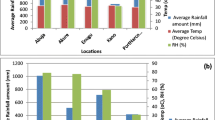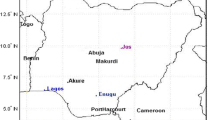Abstract
In this paper, validation of rain climatic zone classifications for Nigeria is presented based on global radio-climatic models by the International Telecommunication Union-Radiocommunication (ITU-R) and Crane. Rain rate estimates deduced from several ground-based measurements and those earlier estimated from the precipitation index on the Tropical Rain Measurement Mission (TRMM) were employed for the validation exercise. Although earlier classifications indicated that Nigeria falls into zones P, Q, N, and K for the ITU-R designations, and zones E and H for Crane’s climatic zone designations, the results however confirmed that the rain climatic zones across Nigeria can only be classified into four, namely P, Q, M, and N for the ITU-R designations, while the designations by Crane exhibited only three zones, namely E, G, and H. The ITU-R classification was found to be more suitable for planning microwave and millimeter wave links across Nigeria. The research outcomes are vital in boosting the confidence level of system designers in using the ITU-R designations as presented in the map developed for the rain zone designations for estimating the attenuation induced by rain along satellite and terrestrial microwave links over Nigeria.












Similar content being viewed by others
References
Abdulrahman AY, Rahman TA, Rafiqul IM, Olufeagba BJ, Abdulrahman TA, Akanni J, Amuda SAY (2014) Investigation of the unified rain attenuation prediction method with data from tropical climates. IEEE Antennas Wirel Propag Lett 13:1108–1111. doi:10.1109/LAWP.2014.2329778
Adimula I, Falaiye O, Willoughby A (2006) Effects of rain on microwave and satellite communications in equatorial and tropical regions. Niger J Physiol 17:66–71. doi:10.4314/njphy.v17i1.37994
Ajayi GO, Feng S, Radicella SM, Reddy BM (eds) (1996) Handbook on radiopropagation related to satellite communications in tropical and subtropical countries. International Centre for Theoretical Physics, Trieste
Ajayi GO, Ofoche EBC (1984) Some tropical rainfall rate characteristics at Ile-Ife for microwave and millimeter wave applications. J Appl Meteorol 23:562–567. doi:10.1175/1520-0450(1984)023<0562:STRRCA>2.0.CO;2
Brussaard GG, Dijk JJ, Wijdemans L (1993) 11 GHz Satellite Beacon Data in the Western Pacific Basin. Technische Universiteit Eindhoven, Eindhoven
Crane RK (1980) Prediction of attenuation by rain. IEEE Trans Commun 28:1717–1733. doi:10.1109/TCOM.1980.1094844
Crane RK (1985) Evaluation of global and CCIR models for estimation of rain rate statistics. Radio Sci 20:865–879. doi:10.1029/RS020i004p00865/abstract
Crane RK (1996) Electromagnetic Wave Propagation through Rain. Wiley, New York {Fashuyi, 2006 #299}
Emiliani LD, Agudelo J, Gutierrez E, Restrepo J, Fradique-Mendez C (2004) Development of rain-attenuation and rain-rate maps for satellite system design in the Ku and Ka bands in Colombia. IEEE Antennas Propag Mag 46:54–68. doi:10.1109/MAP.2004.1396736
Fashuyi MP, Owolawi A, Afullo TJ (2006) Rainfall rate modelling for LoS radio systems in South Africa. Trans South Afr Inst Electr Eng (SAIEE) 97:74–81
Ibiyemi TS, Ajewole MO, Ojo JS, Obiyemi OO (2012) Rain rate and rain attenuation prediction with experimental rain attenuation efforts in south-western Nigeria. 20th Telecommunications Forum (TELFOR) :327–329 doi:10.1109/TELFOR.2012.6419213
Isikwue B, Ikoyo A, Utah E (2013) Analysis of rainfall rates and attenuations for line–of–sight EHF/SHF radio communication links over Makurdi, Nigeria. Res J Earth Planetary Sci 3:60–74
Ito C, Hosaya Y (1999) Worldwide 1-min. rain rate distribution prediction method which uses thunderstorm ratio as regional climatic parameter. Electron Lett 35:1585–1587. doi:10.1049/el:19991098
Jin-Teong O, Chun-Ning Z (1997) Rain rate measurements by a rain gauge network in Singapore. Electron Lett 33:240–242
McCarthy DK, Allnutt JE, Salazar WE, Wanmi F, Tchinda M, Ndinayi TDG, Zaks C (1994a) Results of 11.6 GHz radiometric experiment in Cameroon: second year. Electron Lett 30:1449–1450. doi:10.1049/el:19940951
McCarthy DK, Allnutt JE, Salazar WE, Sitati RW, Okoth M, Mutungi MJ, Odhiambo CD, Zaks C (1994b) Results of 11.6 GHz radiometric experiment in Kenya: second year. Electron Lett 30:1450–1452. doi:10.1049/el:19940952
McCarthy DK, Allnutt JE, Salazar WE, Omeata EC, Owolabi BR, Oladiran T, Ojeba EB, Ajayi GO, Raji TI, Zaks C (1994c) Results of 11.6 GHz radiometric experiment in Nigeria: second year. Electron Lett 30:1452–1453. doi:10.1049/el:19940953
Moupfouma F (1987) Rain induced attenuation prediction model for terrestrial and satellite-earth microwave links. Ann Des Telecommunications Ann Telecommunications 42:539–550. doi:10.1007/BF02994985
Moupfouma F, Martin L (1995) Modeling of the rainfall rate cumulative distribution for the design of satellite and terrestrial communication systems. Int J Satell Commun 13:105–115. doi:10.1002/sat.4600130203
Obiyemi OO, Afullo TJ, Ibiyemi TS (2014a) Equivalent 1-minute rain rate statistics and seasonal fade estimates in the microwave band for south-Western Nigeria. Int J Sci Eng Res 5:239–244
Obiyemi OO, Ojo JS, Ibiyemi TS (2014b) Performance analysis of rain rate models for microwave propagation designs over tropical climate. Prog Electromagn Res M 39:115–122. doi:10.2528/PIERM14083003
Obiyemi OO, Ibiyemi TS, Adetan O (2015) Recent update on one-minute rainfall rate measurements for microwave applications in Nigeria. Int J Wirel Commun Mob Comput 3:33–39
Odedina MO, Afullo TJO (2007) Rain attenuation prediction along terrestrial paths in South africa using existing attenuation models. In: AFRICON 2007 I.E. 1–7. doi:10.1109/AFRCON.2007.4401596
Ojo JS, Ajewole MO (2011) Dimensional Statistics of rainfall Signature and Fade Duration for Microwave Propagation in Nigeria. XXXTH URSI Genaral Assembly and Scientific Symposium, 13-20th August, Istanbul doi:10.1109/URSIGASS.2011.6050807
Ojo JS, Falodun SE (2012) NECOP propagation Experiment: Rain-rate distributions observations and prediction model Comparisons. Int J Antennas Propagation. doi:10.1155/2012/913596
Ojo JS, Omotosho TV (2013) Comparison of 1-minute rain rate derived from TRMM satellite data and raingauge data for microwave applications in Nigeria. J Atmos Sol Terr Phys 102:17–25. doi:10.1016/j.jastp.2013.04.008
Omotosho TV, Oluwafemi CO (2009) One-minute rain rate distribution in Nigeria derived from TRMM satellite data. J Atmos Sol Terr Phys 71:625–633. doi:10.1016/j.jastp.2009.02.003
Omotosho TV, Willoughby AA, Akinyemi ML, Mandeep JS, Abdullah M One year results of one minute rainfall rate measurement at Covenant University, Southwest Nigeria. In: International Conference on Space Science and Communication (ICONSPACE), 2013 I.E. Melaka 1–3 July 2013.98–101. doi:10.1109/IconSpace.2013.6599441
Owolawi PA (2010) Characteristics of rain at microwave and millimetric bands for terrestrial and satellite links in South Africa and surrounding islands. University of KwaZulu Natal
Owolawi PA (2011) Rainfall rate probability density evaluation and mapping for the estimation of rain attenuation in South Africa and surrounding islands. Prog Electromagn Res 112:155–181. doi:10.2528/PIER10082504
Radiowave Propagation Series ITU (1994) Characteristics of precipitation for propagation modelling. ITU-R, Geneva
Radiowave Propagation Series ITU (2012) Characteristics of precipitation for propagation modelling. ITU-R, Geneva
Rice P, Holmberg N (1973) Cumulative time statistics of surface-point rainfall rates. IEEE Trans Commun 21:1131–1136. doi:10.1109/TCOM.1973.1091546
Sarkar S, Ahmed I, Prasad M, Dutta H, Reddy B (1992) Rain rate distribution over the Indian subcontinent. Reference data manual
Semire FA, Mohd-Mokhtar R, Omotosho TV, Widad I, Mohamad N, Mandeep J (2012) Analysis of cumulative distribution Function of 2-year rainfall measurements in Ogbomoso, Nigeria. Int J Appl Sci Eng 10:171–179
Semire FA, Mohd-Mokhtar R, Widad I, Mohamad N, Mandeep JS (2013) Categorical Statistical approach to satellite Retreived rainfall data analysis in Nigeria. Sci Res Essays 8:2123–2137
Shoewu OO, Akinyemi LAO (2013) The effect of climatic Change on GSM signal propagation. Res J Comput Syst Eng 4:471–478
Author information
Authors and Affiliations
Corresponding author
Rights and permissions
About this article
Cite this article
Obiyemi, O.O., Ibiyemi, T.S. & Ojo, J.S. On validation of the rain climatic zone designations for Nigeria. Theor Appl Climatol 129, 341–351 (2017). https://doi.org/10.1007/s00704-016-1787-9
Received:
Accepted:
Published:
Issue Date:
DOI: https://doi.org/10.1007/s00704-016-1787-9




